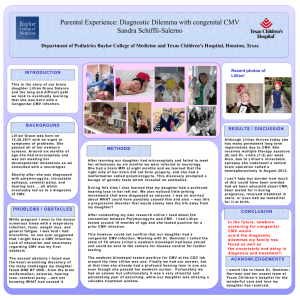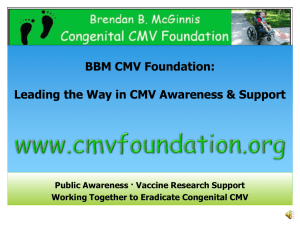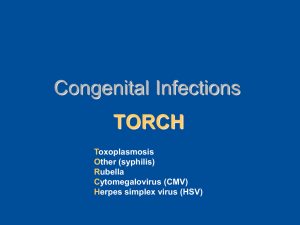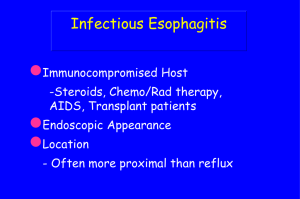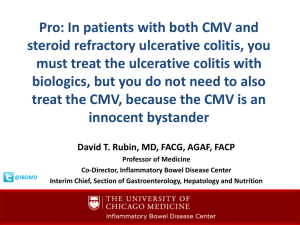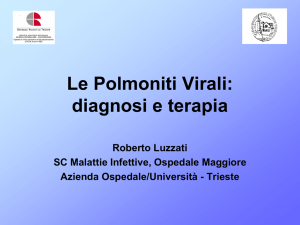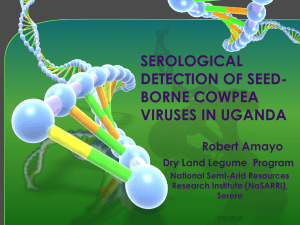Reducing CMV Negative Blood Transfusion in Pediatric Hematology
advertisement
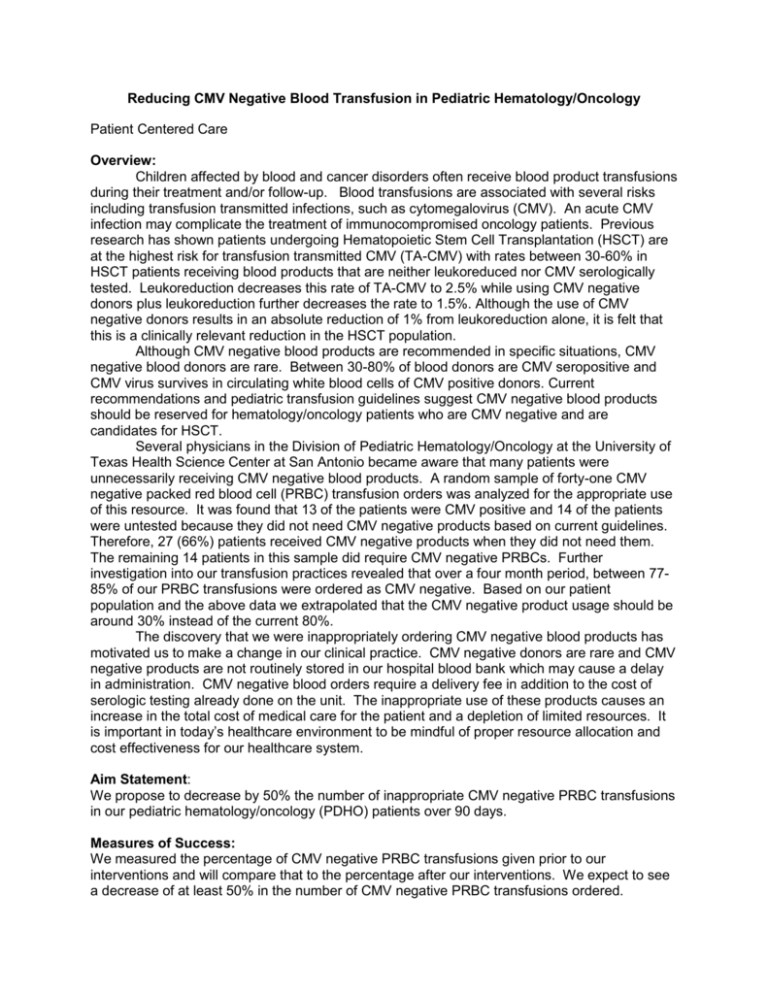
Reducing CMV Negative Blood Transfusion in Pediatric Hematology/Oncology Patient Centered Care Overview: Children affected by blood and cancer disorders often receive blood product transfusions during their treatment and/or follow-up. Blood transfusions are associated with several risks including transfusion transmitted infections, such as cytomegalovirus (CMV). An acute CMV infection may complicate the treatment of immunocompromised oncology patients. Previous research has shown patients undergoing Hematopoietic Stem Cell Transplantation (HSCT) are at the highest risk for transfusion transmitted CMV (TA-CMV) with rates between 30-60% in HSCT patients receiving blood products that are neither leukoreduced nor CMV serologically tested. Leukoreduction decreases this rate of TA-CMV to 2.5% while using CMV negative donors plus leukoreduction further decreases the rate to 1.5%. Although the use of CMV negative donors results in an absolute reduction of 1% from leukoreduction alone, it is felt that this is a clinically relevant reduction in the HSCT population. Although CMV negative blood products are recommended in specific situations, CMV negative blood donors are rare. Between 30-80% of blood donors are CMV seropositive and CMV virus survives in circulating white blood cells of CMV positive donors. Current recommendations and pediatric transfusion guidelines suggest CMV negative blood products should be reserved for hematology/oncology patients who are CMV negative and are candidates for HSCT. Several physicians in the Division of Pediatric Hematology/Oncology at the University of Texas Health Science Center at San Antonio became aware that many patients were unnecessarily receiving CMV negative blood products. A random sample of forty-one CMV negative packed red blood cell (PRBC) transfusion orders was analyzed for the appropriate use of this resource. It was found that 13 of the patients were CMV positive and 14 of the patients were untested because they did not need CMV negative products based on current guidelines. Therefore, 27 (66%) patients received CMV negative products when they did not need them. The remaining 14 patients in this sample did require CMV negative PRBCs. Further investigation into our transfusion practices revealed that over a four month period, between 7785% of our PRBC transfusions were ordered as CMV negative. Based on our patient population and the above data we extrapolated that the CMV negative product usage should be around 30% instead of the current 80%. The discovery that we were inappropriately ordering CMV negative blood products has motivated us to make a change in our clinical practice. CMV negative donors are rare and CMV negative products are not routinely stored in our hospital blood bank which may cause a delay in administration. CMV negative blood orders require a delivery fee in addition to the cost of serologic testing already done on the unit. The inappropriate use of these products causes an increase in the total cost of medical care for the patient and a depletion of limited resources. It is important in today’s healthcare environment to be mindful of proper resource allocation and cost effectiveness for our healthcare system. Aim Statement: We propose to decrease by 50% the number of inappropriate CMV negative PRBC transfusions in our pediatric hematology/oncology (PDHO) patients over 90 days. Measures of Success: We measured the percentage of CMV negative PRBC transfusions given prior to our interventions and will compare that to the percentage after our interventions. We expect to see a decrease of at least 50% in the number of CMV negative PRBC transfusions ordered. Use of Quality Tools: In order to identify the areas for potential improvement of our problem we created a process flow chart and a fishbone diagram. Several areas for improvement were identified: 1. Medical Assistant/Nurse – The pediatric hematology/oncology clinic is very busy with a high volume of patients seen daily. The nursing staff is very familiar with many of the patients and at times will anticipate the need for a blood product transfusion and pre-order CMV negative products on all patients which results in incorrect use of this resource. In addition to improper ordering practices, there is a lack of understanding by the nursing staff as to which patients require CMV negative blood products. 2. Faculty/Nurse Practitioner/Fellow/Resident - There are currently no standardized outpatient order sets for blood product transfusions. Many providers also have a lack of knowledge and continue to order all blood products with leukoreduction and as CMV negative for all patients regardless of diagnosis. The residents, who do most of the inpatient ordering, have a lack of experience/understanding with blood product ordering and will order CMV negative products to avoid missing a patient who may really require negative products. Residents also model their practices after faculty members who are inappropriately ordering CMV negative products. 3. Blood Bank – One of the largest problems we encountered was that our hospital blood bank was marking all patients who had received any previous CMV negative blood products as requiring CMV negative products for all subsequent transfusions. The blood bank would contact the ordering provider to tell them to change the order to CMV negative. If a patient had previously received only leukoreduction and suddenly had CMV negative blood ordered, the blood bank would not question this change in status, but mark the patient as now requiring CMV negative blood. There was no mechanism in place to validate the patients’ actual CMV status. 4. Patient – Many patients had unclear diagnoses or did not have any CMV testing performed at diagnosis. This created confusion and many patients would receive CMV negative blood products by default. Interventions: The overall plan for improvement was based on education for all individuals involved in the process of blood product transfusions. The specifics of this education included: 1. Medical Assistant/Nurse – Reinforcement that no blood products should be pre-ordered without a written order from a provider. Labels were placed on clinic charts identifying which patients required CMV negative blood. 2. Faculty/Nurse Practitioner/Fellow/Resident – We created and distributed a decision tree tool as seen below. We discussed our project and intervention strategies at a division meeting to disseminate the information to the faculty, nurse practitioners and fellows. Our resident representative discussed the decision tree and standardized order set with the complete residency program as part of their Housestaff Inpatient School. Residents on the inpatient hematology/oncology service also receive a monthly lecture on transfusions that includes guidelines for CMV negative blood product usage. 3. Blood Bank – Correct labeling of patients that required CMV negative blood products was completed by the blood bank and Dr. Frei-Jones. A new process was implemented that questioned any CMV negative order on a patient that was identified as not needing CMV negative products. New patients were identified as requiring CMV negative or CMV safe products at the beginning of treatment and this status was included in the patient medical record. 4. Patient- Labels were placed on the chart identifying patients that required CMV negative blood. Intervention Timeline: April 26th, 2012 – Faculty create CMV decision tree May, 2012 – Begin to place transfusion labels on clinic charts May 8th, 2012 – Updated CMV status with hospital blood bank June, 2012 – Nursing meeting to discuss changes/education August 9th, 2012 – Housestaff Inpatient School lecture Results: Revenue Enhancement/Cost Avoidance/Generalizability: Currently, no CMV negative blood products are stored in our hospital blood bank. Any CMV negative product that is ordered must be delivered from the South Texas Blood and Tissue Center located in San Antonio. The extra cost is included in the contract that has been negotiated between the hospital and the South Texas Blood and Tissue Center. The added cost per CMV negative PRBC unit is $36.00. Before our interventions we were ordering 80% CMV negative PRBCs at an extra cost of $2,880.00 per 100 units. At the current rate of 40% CMV negative PRBCs being ordered we will save approximately $1,440.00 per 100 units ordered. We expect that as we are able to expand our interventions and reduce the amount of CMV negative platelets, fresh frozen plasma (FFP), and cryoprecipitate ordered we will see a significantly larger cost savings for the hospital. Conclusions and next steps: Blood product transfusions are given to many children diagnosed with a hematology/oncology disorders. CMV negative blood products are a valuable resource and are indicated for a very specific patient population. Our project identified incorrect usage of CMV negative blood products and provided us with an opportunity to improve our practices. We were able to implement several simple measures that potentially will have an impact on our ordering procedures and reduce the unnecessary use of CMV negative blood products. Based on our very limited data it appears that we have seen a reduction of approximately 50% in the usage of CMV negative PRBCs. We plan to continue with our current monitoring system and expect to see a sustained change in practice. We plan to extend our interventions and monitoring of blood product ordering to include platelets, FFP, and cryoprecipitate. We plan to educate providers and staff on the other medical/surgical services within our hospital on proper blood product ordering and usage. Finally, we will be working with the IT department to create standardized order sets to be used in the new and upcoming computerized physician order entry system that will be used hospital wide as well as a method to identify CMV status within the patient electronic medical record.
